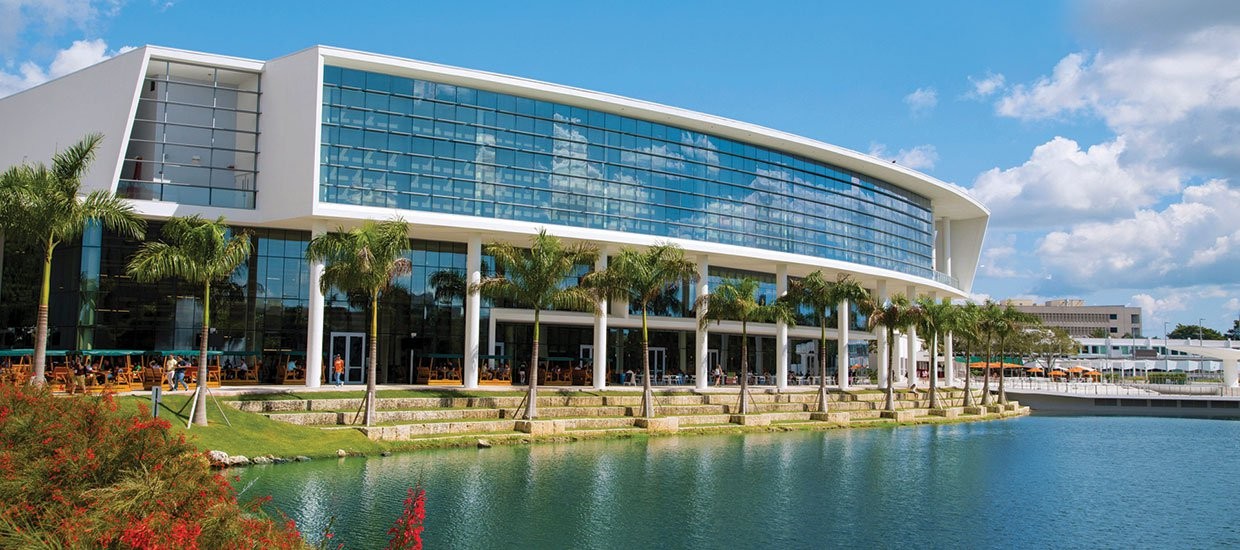University of Miami’s team-taught class exposes students to Miami’s communities
At the Black Archives in Overtown, a group of students gazed at the remnants of a scorched cross that was planted at a Miami Shores church by the Ku Klux Klan.
In Little Havana, they stood solemnly in front of the monument and a flame that commemorates the death of members of the 2506 Brigade, who fell during the Bay of Pigs Invasion in Cuba.
All 28 students enrolled in the University of Miami School of Communication course “Covering Global Issues in Miami” were experiencing the amalgam of cultures and ethnic enclaves that make up Miami. The interdisciplinary course attracted 26 students from the Universidad de Navarra in Spain, who are studying global journalism.
The class exposes these students, many of whom will be future journalists, to the intricacies of covering global issues in a way that is sensitive to the varying cultures, ethnicities, and communities, said Sallie Hughes, School of Communication professor and associate dean for Global Initiatives.
“The aim of the course is to make them aware that globalization is grounded in different communities, in people’s lives,” said Hughes. “Miami is the perfect place to do this.”
Exploring various themes, which include migration, equity, media, and climate change, “Covering Global Issues in Miami” pairs classroom lectures and exercises with field trips to various iconic communities, including Little Haiti, Liberty City, Little Havana, Coconut Grove, and Overtown. In their visits, the students also met with community leaders, county government officials, and journalists who all briefed them about their work.
Little Havana
Mercedes Medina, a communications professor from the Universidad de Navarra, escorted the group from Spain who are enrolled in a bilingual program called Global Journalism.
“Miami is the central place to learn all that is happening in America. We believe Miami to be the capital of America,” she said. “Miami is a city so international that it allows them to experience the many cultures and the many problems that exist in today’s world.”
The students also took part in morning lectures from experts in their fields. These included Michael Bustamante, associate professor of history and the Emilio Bacardí Moreau Chair in Cuban and Cuban-American Studies at the University, who offered the students a thorough overview of the Cuban exile community.
Valeria Silvacoa, a student from Universidad de Navarra, said she felt that after the lecture, the tour of Little Havana brought Bustamante’s words to life.
“I got to experience the culture with all its tastes and sounds,” she said. “One nice man at Domino Park even taught me the art of playing dominoes, Cuban style.”
During the visit to the Black Archives in Overtown, Kamila E. Prichett, the executive director of the archives, spoke with the students about the history of racism in Miami and its implications today.
Global communication class in the field
It was that type of community engagement that drew Zanolee Grant, an M.F.A. graduate student at the University, to take the course.
“I think one of the best takeaways of this course is the fact that it puts the community front and center,” she said. “It helps us [as journalists] . . . to report what we see, but also it helps us to bring humanity and others’ into a project.”
Donette Francis, director for the Center for Global Black Studies and associate professor of English, shared the “hidden stories” of Black Miami and the work of writers, filmmakers, artists, and intellectuals with the students.
Rene Rodriguez, School of Communication lecturer and manager of the Bill Cosford Cinema, gave a presentation on how Miami has been portrayed in films from the 1940s to present day.
The class is a collaboration that included the aforementioned instructors and Universidad de Navarra assistant professor Aurken Sierra, as well as other School of Communication faculty members. Among them are Alberto Cairo, Kim Grinfeder, Gina Presson, and Vinicius Sueiro, with support from Ph.D. students Hannah Artman, Luis Garcia Conde, and Kyle Walkine.
Grouped into six teams, the students will develop multimedia projects about the neighborhoods and global issues they studied. Each team will present its project at the end of the course.
The classroom lectures really impressed Sergio Duran, a student from Universidad de Navarra, who wants to be a political analyst.
“I have found all the lectures very professional, and all the professors are very competent,” he said. “Listening to Professor Cairo, learning how to use graphics, and learning that graphics do not only include math but logic as well—it all makes sense.”

